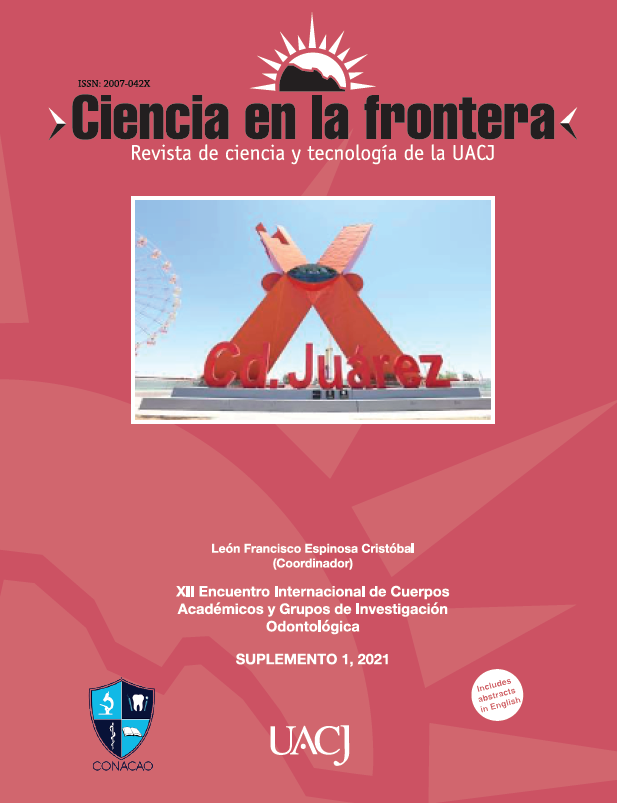Evaluación de la adaptación marginal en restauraciones indirectas de resina utilizando diferentes protocolos de adhesión
Palabras clave:
adaptación marginal, estereomicroscopio, adhesivo, resina, fotocuradoResumen
Introducción: actualmente la búsqueda de procedimientos adhesivos con un éxito clínico a largo plazo ha aumentado considerablemente. Uno de los aspectos importantes para la cementación adhesiva es realizar o no un previo fotocurado del agente adhesivo y de sus repercusiones. Objetivo: evaluar la adaptación marginal de restauraciones indirectas de resina utilizando diferentes sistemas de adhesión mediante estereomicroscopio.
Metodología: 60 premolares extraídos por ortodoncia con estructura coronaria íntegra con preparación tipo overlay; se fabricaron incrustaciones de resina fluida inyectada y se evaluó la adaptación marginal usando estereomicroscopio y se cementaron las restauraciones empleando Prime and Bond Universal, Tetric n Bond y Optibond fl. Resultados: el adhesivo con el que se reportó una mejor adaptación marginal al ser prefotocurado fue Tetric n Bond (62.72 ± 22.40), seguido de Prime and Bond Universal (51.36 ± 18.35) y, por último, Optibond fl (42.19 ± 16.28) (p = 0.005). Conclusión: la mejor adaptación marginal, se observó cuando no se realiza prefotocurado del adhesivo.
Citas
ADA Council on Scientific Affairs; ADA Council on Dental Benefit Programs. Statement on posterior resin-based composites. J Am Dent Assoc 1998;129:1627–1628.
Addison O, Marquis PM, Fleming GJ. Quantifying the strength of a resin-coated dental ceramic. J Dent Res 2008;87(6):542–7.
Angeletaki F., Gkogkos A., Papazoglou E., Kloukos D. Direct versus indirect inlay/onlay composite restorations in posterior teeth. A systematic review and meta-analysis. J. Dent. 2016;53:12–21.
Cao L., Zhao X., Gong X., Zhao S. An in vitro investigation of wear resistance and hardness of composite resins. Int. J. Clin. Exp. Med. 2013;6:423–430.
Clausen J-O, Abou Tara M, Kern M. Dynamic fatigue and fracture resistance of non-retentive all-ceramic full coverage molar restorations. Influence of ceramic material and preparation design. Dental Materials. 2010 Jun; 26(6):533–8.
Cramer NB, Stansbury JW, Bowman CN. Recent advances and developments in composite dental restorative materials. J Dent Res 2011;90:402–416.
D’Arcangelo C., Zarow M., De Angelis F., Vadini M., Paolantonio M., Giannoni M., D’Amario M. Five-year retrospective clinical study of indirect composite restorations luted with a light-cured composite in posterior teeth. Clin. Oral Investig. 2014;18:615–624.
Heintze SD, & Rousson (2012) Clinical effectiveness of direct class II restorations—A meta-analysis Journal of Adhesive Dentistry14(5)407-431.
Magne P, Belser U, Bonded Porcelain Restorations in the Anterior Dentition – A Biomimetic Approach Quintessence Publishing Co, 2002 Chicago, IL 52
Magne P, Schlichting LH, Maia HP, Baratieri LN. In vitro fatigue resistance of CAD/CAM composite resin and ceramic posterior occlusal veneers. J Prosthet Dent. 2010 Aug; 104(3):149–57.
Manso AP, Carvalho RM, Dental Cements for Luting and Bonding Restorations: Self-Adhesive Resin Cements, Dent Clin North Am. 2017 Oct;61(4):821-834.
Moraes R.R., Gonçalves L.S., Lancellotti A.C., Consani S., Correr-Sobrinho L., Sinhoreti M.A. Nanohybrid resin composites: Nanofiller loaded materials or traditional microhybrid resins? Oper. Dent. 2009;34:551–557.
Opdam N, Frankenberger R, Magne P., From Direct Versus Indirect Toward an Integrated Restorative Concept in the Posterior Dentition. Oper Dent, 2016;Sep;41(S7):S27-S34
Opdam NJM,van de Sande FH, Bronkhorst E, Cenci MS, Bottenberg P, Pallesen U, Gaengler P, Lindberg A, Huysmans MC, van Dijken JW. Longevity of posterior composite restorations: a systematic review and meta-analysis. J Dent Res 2016;93:943-949.)
Peumans M, De Munck J, Van Landuyt K, et al. Two-year clinical evaluation of a self-adhesive luting agent for ceramic inlays. J Adhes Dent 2010;12(2):151–61.
Politano G, Fabianelli A, Papacchini F, Cerutti A., The use of bonded partial ceramic restorations to recover heavily compromised teeth, Int J Esthet Dent. Autumn 2016;11(3):314-36.
Soares PV, Santos-Filho PC, Gomide HA, Araujo CA, Martins LR, Soares CJ. Influence of restorative technique on the biomechanical behavior of endodontically treated maxillary premolars. Part II: Strain measurement and stress distribution. J Prosthet Dent 2008;99:114–122.
Tagami A, Takahashi R, Nikaido T, Tagami J. The effect of curing conditions on the dentin bond strength of two dualcure resin cements. J Prosthodont Res 2017; 61: 412-418.


